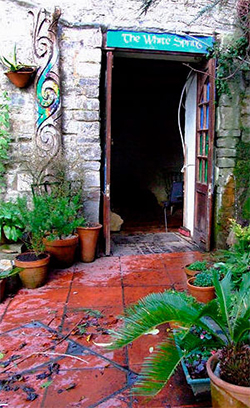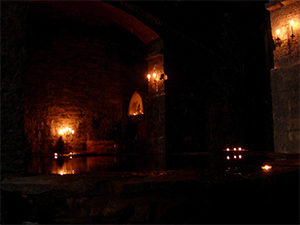A Temple of life
The primary purpose of the temple is to honour The Spirit of the White Spring. It is an expression of gratitude for the gift of pure water. It is a sanctuary, a place of reflection, inspiration and healing. It is a sacred site of great depth and beauty. It is a living temple.
In dedication to the spiritual energies of this place, we have created sacred pools and re-instated the shrines within the sanctuary. We are well on our way to the realisation of a magnificent water temple. This honours the space as one of the most sacred sites in the Western World; in Glastonbury, the 'Holiest Earthe in England'.
The temple is created by, cared for and supported by the Companions of the White Spring. Men and women who give their time and resources freely, for the love of it, and find their lives blessed. In keeping with our belief in the sacredness of all creation we endeavor only to use natural and pre-used materials.
We have regular gatherings to celebrate and mark the seasonal changes throughout the year and regular full and dark moon meditations. Individuals and groups from all Spiritual paths and traditions who come in peace are welcomed.
We are independent of state or institutional funding and intend to remain so. In true temple tradition, no one is paid, no one is charged, and there is no expectation of donation. Gifts and contributions are most welcome; if you wish to help in this way please contact us or contribute here.
history
Glastonbury has been long honoured as a sacred site. Here, it is said, lies the foundations of the earliest church in Britain. Probably one of the first in whole world and maybe second only to Jerusalem. This Church was dedicated to Mary. Glastonbury Tor, known as the Holy Hill of Albion, England’s sacred mountain, was a place of great importance and a place of Ancient Goddess worship.
'Glastonbury is one of Britain's most important sites of pilgrimage. For millennia people have been drawn to it seeking the mythical Isle of Avalon. It was once an island separated from the mundane world by a shallow sea, part of the Bristol Channel and Atlantic Ocean. An archipelago of islands and treacherous marshes marked a dangerous and mysterious land in ancient times before the shallow sea was drained. Yet water still rises and falls from its heart in profusion.
The existence of the springs at the foot of Glastonbury Tor would have been highly significant to our ancestors. Due to the geology of the hill, it has lots of aquifers and hence springs, and the red and white waters have never dried up. Springs and wells were sacred to life. With the abundance of fresh water and the spiritual associations of the prominent Tor, this sacred site would have been a place of great importance.
There is evidence to support the existence of a monastic site at the summit of Glastonbury Tor. Excavations have uncovered remains of what is thought to be a monastery, and further archeology revealed evidence of two monastic cells on the Western side of the Tor. It is likely that early Celtic Christian hermits once lived on the sacred site of the White Spring.
The well house was constructed over the spring, to provide a reservoir in 1872. The clean water, which it provided for the town suffering with cholera, was a great blessing. Sadly a beautiful coombe was destroyed as a consequence. A local teacher, George Wright (1896) wrote:
“And what was Glastonbury like then? One thing that clings to me was the beautiful Well House Lane of those days, before it had been spoilt by the erection of the reservoir. There was a small copse of bushes on the right hand running up the hill, and through it could be, not seen, but heard, the rush of running water, which made itself visible as it poured into the lane. But the lane itself was beautiful, for the whole bank was a series of fairy dropping wells – little caverns clothed with moss and vedure, and each small twig and leaf was a medium for the water to flow, drop, drop, drop into a small basin below. This water contained lime, and pieces of wood or leaves subject to this dropping became encrusted with a covering of lime. For a long time I attended those pretty caverns with affectionate care, and Well House Lane was an object of interest to all our visitors”
The reservoir was not in use for very long; the high calciferous content of the water caused pipes to block and by the end of the 19th century water was piped into Glastonbury from out of town. The building fell into disuse, forgotten.
In the 1980’s it was awakened; doors were built to provide access to the stone reservoir, drinking water was made available and shops and cafes leased the building. In 2004, the building came into new ownership with the intent of re-establishing sacred space here. The temple was consecrated in 2005. The vision has been held, realised and made manifest by Companions of the White Spring.
What we have done
The building has had the walls, floors, water pipes and chemical paint (all installed in the 1980s) removed. The high ceilings, bowed floors, and beautiful stone walls have been uncovered; revealing the magnificent Cathedral-like structure of the place. The water now flows freely and beautifully inside and out.
In October 2009 a series of beautiful pools were built inside. The designs were created according to the principles of sacred geometry, and by those who have the knowledge and love of the waters and the land of Avalon. Thought has been given to the opportunity for visitors and pilgrims to gaze into the water, to step into the pools, or full submergence in the healing pool.
Every step of the process has been undertaken prayerfully and for the love of it. Many helpers and companions have felt inspired to take part in the physical creation of this wonderful place. We hope you will visit the White Spring. We are encouraged by the progress so far.
New projects
The White Spring continues to evolve as a potent sacred site in Glastonbury. Forever unfolding and growing in beauty; being led in due season by spirit, this living temple is constantly changing in subtle and sometimes more obvious ways. All of the consecrated shrines are redressed frequently.
The seasonal altar, where visitors are welcome to make offerings from nature, changes at each turn of the wheel. Each year, the beautiful bower that forms part of the Brigid shrine is rebuilt with fresh hazel in preparation for Imbolc, which we celebrate on February 1st in conjunction with Chalice Well and Bride's Mound.
We are now inspired to push on to the next phase, enhancing the doors and entrance ways and paying special attention to the courtyard and the manifestation of a beautiful garden.







